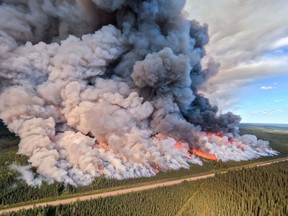A drought that has persisted for a year and a half is likely to lead to a “bleak” wildfire season in 2024, forecasters warn.

Article content
A drought that has extended across much of British Columbia since fall 2022 could be a harbinger of a “bleak” wildfire season, forecasters warn.
Armel Castellan, a meteorologist with Environment Canada, based in Victoria, says there is no indication that the spring weather will be wet enough to moderate what he describes as “incredibly low levels” of precipitation and snowpack over the past 18 months in most areas of British Columbia.
Advertisement 2
Article content
Article content
“We are still not recovering from the lack (of precipitation) we have had consistently since August 2022.”
Dry conditions are particularly bad at the Prince George Fire Center in the northeast corner of British Columbia, where two new fires broke out last month.
There are still 93 cataloged fires from last season across the province, the vast majority of which are in the Prince George region and have been burning or smoldering since the summer.
However, other fires started in late October at the Cariboo Fire Center, and two in the Prince George area started in late January and last Friday.
While none are listed as notable wildfires, indicating a fire of significant scale or one that threatens people and property, they are a worrying predictor of what could happen before summer.
Castellan says a rainy stretch from November to January has “somewhat replenished” water supplies in several regions, including coastal British Columbia, but “every (weather) station we monitor is in deficit.”
He points out that drought is not just about the amount of precipitation that falls. Seasonal temperatures also play a key role.
Article content
Advertisement 3
Article content
For example, Castellan says December 2023 was the warmest on record in many parts of British Columbia, including Vancouver, Abbotsford and Comox. That means more evaporation from falling rain and less snow at higher elevations.
Therefore, a generally warmer climate prolongs and intensifies drought. “It’s a huge piece if temperatures rise,” she says.
The snowpack analysis is “trending toward historic levels,” with depths the lowest recorded since data was collected from at least the 1980s to the present. “In the last 40 or 50 years, this is the worst it’s ever been from a snow perspective.”
While snow is forecast this week, it’s not likely to do much to change the reality that snowpack is at 60 per cent of normal levels in British Columbia’s mountains heading into spring.

The Ministry of Forests says the BC Wildfire Service and its partners have adopted an annual rather than seasonal model and are investing money from the 2024 BC budget into fire prevention and management.
The provincial budget calls for $154 million more in operating cash and $21 million in capital over the next three years for additional infrastructure, recovery and wildfire response resources, the ministry says in a statement.
Advertisement 4
Article content
However, Prime Minister David Eby said last week that he is “deeply concerned” about what lies ahead, highlighting last summer’s severe drought and billion-dollar battle: most destructive wildfire season on file.
The 2024 budget includes $38 million more to hire wildland fire service team leaders and frontline personnel who will work to protect structures, prevent and reduce fire risk, and assist with ecosystem recovery and repair infrastructure affected by fires. forestry.
While Alberta has declared an early start to wildfire season, British Columbia is now on year-round fire alert, largely due to the effects of a warming climate and increasingly extreme weather events, Castellan says.
For example, Castellan says northeastern British Columbia fell to lows of -40 degrees Celsius in January before a sudden shift to -10 degrees Celsius.
The unsettled weather in the area even caused a lightning strike which, while it did not cause a bushfire, suggests the bushfire service should be on alert for the potential for fires caused by lightning even now.
Castellan says the national weather agency ran the numbers on what to expect this spring in mid-February, and models show that temperatures are likely to be above seasonal from March to May across virtually all of Canada, except for some parts of the far north.
Advertisement 5
Article content
Forecasting spring precipitation is more complicated, Castellan says, although it is clear that the El Niño pattern that has prevailed for the past several years has been fading since about December. This typically leads to drier and colder conditions, but the transition to La Niña might not have a big effect on British Columbia’s weather patterns until perhaps next winter, he says.
“Everything is still on the table (in terms of forecasts), but right now the outlook is bleak,” he says. “We have every indication that this spring and summer are heavily tilted toward increased wildfire risk.”
That will likely mean more smoke, heat and health problems across much of the province this spring and summer. And it’s a concern that should be on everyone’s mind, not just firefighters and emergency managers, she says.
“Anyone who has a pair of lungs will remember how traumatizing it is, from a health standpoint, to have wildfires in your neighborhood from May until mid-winter.”
Recommended by Editorial
-

Premier David Eby ‘deeply concerned’ about BC fire season as billions prepare for contingencies
-

BC Budget 2024: Money to address climate emergencies is all talk, critics say
Bookmark our website and support our journalism: Don’t miss the news you need to know – add VancouverSun.com and LaProvincia.com to your favorites and subscribe to our newsletters here.
You can also support our journalism by becoming a digital subscriber – for just $14 a month you can get unlimited access to The Vancouver Sun, The Province, National Post and 13 other Canadian news sites. Support us by subscribing today: The Vancouver Sun | The province.
Article content


